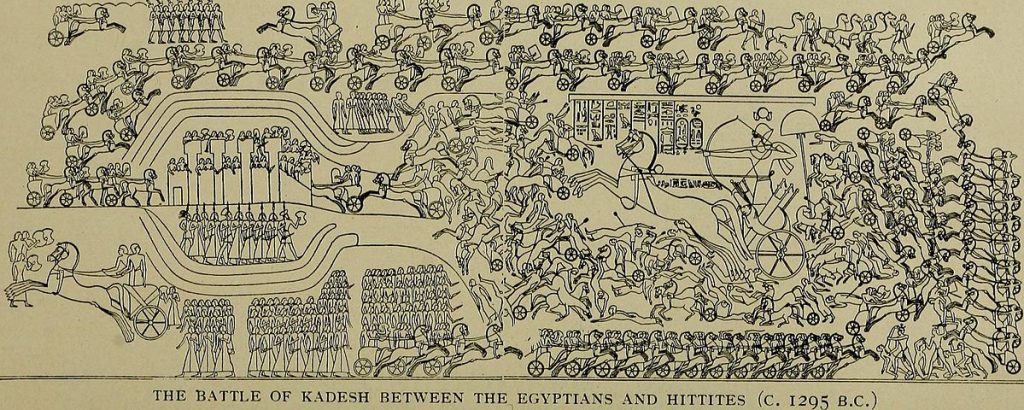The once calm and silent Egyptian landscape became flooded with the sounds of hooves crackling and wheels turning as the Egyptian imperial army approached the land known as Kadesh. The land was located along the Orontes River just upstream from Lake Homs, located in modern day Syria. The Egyptian soldiers stood dormant, gazing at land that once belonged to their king, filled with determination, and longing for revenge against their enemy. Awaiting the order to attack, they readied themselves for battle. This was the prelude to the historic clash known as the Battle of Kadesh.
The battle involved the Egyptians and the Hittites, and it was over land in Syria that the Hittites had recently taken from the Egyptians. Both sides armed themselves with bronze weaponry and horse-drawn chariots equally equipped for a long and taxing battle. The siege by the Egyptians on Kadesh is known to have lasted three months.1 This battle involved between five to six thousand chariots, the largest such engagement in military history. The Hittites were known to be highly skilled in chariot-based combat due to the help of a horse trainer known as Kikkuli. Kikkuli’s teachings helped the horses to increase both endurance and stamina. His teachings were so well regarded that royalty in neighboring Indo-European civilizations adopted his teachings for their own.2 This advanced knowledge and practice that was available to the Hittites already put them at an advantage when facing the Egyptians on chariots. The Egyptians, however, had certain advantages that the Hittites lacked. The Egyptian army, under the command of Ramses II, contained 35,000 men, while the Hittite army, headed by Muwutallis II, only had 27,000 men. Despite their differences, both sides seemed able to face the opposing army with confidence.

Early in the battle the Hittites gained the advantage by having two of their men pose as Egyptian commanders. They “informed” Ramses of the location of the Hittite camp. Ramses then, without thinking, moved his army to the location of the camp. When he arrived, he realized it had been a trap. The Hittites in fact were east of Kadesh and were within striking distance of the Egyptian army stationed there.3 In addition, the rest of the Egyptian army was stationed within striking distance of Kadesh; however, they were commanded to remain idle until Ramses sent word to them. Ramses, being far north from the rest of his army, was unable to send word fast enough about the ambush. Consequently, the Hittite army killed the majority of the Egyptians stationed in Kadesh. The Hittites were able to overpower the Egyptian troops because those stationed in Kadesh were left with no chariots, while the Hittites sent the majority of their chariot forces to overwhelm those Egyptians. Ramses was left with no other choice but ride to Kadesh with his bodyguards to face the Hittite army, while the remainder of the Egyptian army marched towards Kadesh. This act not only illustrates Ramses bravery but also his leadership. Once he arrived, Ramses and his bodyguards attacked the Hittite chariots and infantry units. Muwutallis, however, was not easily discouraged. He continued to send more chariots to Kadesh to overwhelm Ramses. Ramses in response drove all the reinforcements back. Ramses did this by attacking the chariots from the rear wheels. By doing this the Hittite riders would lose control of their horses and have to fight on foot. The Hittites who were left to fight on foot were then no match for Ramses’ forces, armed with his own chariots. This continued until the rest of the Egyptian forces rendezvoused with Ramses at Kadesh. Now left with no other options, Muwutallis sent all of his remaining forces to Kadesh to push back the Egyptian army. The battle lasted for hours, until night fell. Due to both armies being unable to fight in the dark, Ramses and Muwutallis both retreated their armies. The fight for Kadesh, however, continued for months after this battle, until Ramses obtained the victory by driving out Muwutallis’s men and reclaiming Kadesh, according to Egyptian records.4
The results of the battle are still inconclusive. There are many accounts of how the battle ended, even conflicting accounts from the same side. The Egyptian records, for instance, state that the battle ended in a treaty between Ramses and Muwutallis. This record conflicts with Ramses’ proclamation of retaking Kadesh, since the alleged treaty gave Hittites control over portions of Kadesh and other lands. The Hittites mention in their records that the battle was won by Muwutallis. Muwutallis also proclaimed that he forced Ramses to retreat from Kadesh.
This conflict of records leads to several possibilities regarding the outcome. Both sides could have failed to drive out the other, leading Kadesh to be destroyed by the warfare. Ramses could have been spreading propaganda of a victory to disguise his failure, while Muwutallis’s could have done the same. Though the true outcome may be lost to time, the battle still holds merit. The battle was not only fought over a long period of time. It had strategies enacted by both sides and was one of the largest known battles to have used chariot warfare.
- Spencer Tucker, Battles that changed history: an encyclopedia of world conflict (ABC-CLIO, 2010), 4. ↵
- Peter Raulwing, The Kikkuli Text Hittite Training Instructions for Chariot Horses in the Second Half of the 2nd Millennium BC and Their Interdisciplinary Context, PDF (Peter Raulwing, 2009), 5. ↵
- The Greenhaven Encyclopedia of Ancient Mesopotamia, 2007, s.v. ” Battle of Kadesh (ca. 1274 B.C.),” by Don Nardo. ↵
- Antonio Santosuosso, “Kadesh Revisited: Reconstructing the Battle Between the Egyptians and the Hittites,” The Journal of Military History 60, no. 3 (1996): 425. ↵



37 comments
Andrew Dominguez
This was a very good article. I was shocked when the two solders had told Ramses were the army was located. Why would he just rush in without thinking it could be a trap. Another cool thing was how even though he was in the wrong location, he rushed to their actual location to fight. Its weird to think their was no clear winner since the battle lasted hours, and both had to retreat.
Megan Barnett
You started off the article very well by introducing the action, but after that I became very confused on who was doing what. I feel that there was just a lot going on that it was hard to keep up and there was no pictures to understand what was meant by their striking distance. I am also curious as to why the battle occurred in the first place?
Clarissa Bustamante
This was a very interesting article because I don’t think I have ever heard of the battle of Kadesh. The article was very descriptive and explained very well about the battle and how it was a great time of revenge for the Egyptians. This battle must have been very scaring to watch and of course to be fighting in. It was very interesting how there was no clear winner of the battle which comes to show how intense and competitive the battle was.
Michael Mandujano
The main concept that influenced me to read this article was its title, “The Battle with no Winner: The Battle of Kadesh.” Prior to reading this article, I was unfamiliar about the war between the Egyptians and Hittites. However, after reading this article, I found it very interesting how both countries/civilizations were equally armed. Overall, I also find it astonishing how this battle ended in a draw, that is wicked.
Richard Navarro
I’ve never heard of this war before but it is in fact an interesting one! Its cool to see the patriotism these soldiers had even way back in time. I have never heard of a “tie” in the war, these soldiers must have literally fought until they were broken and tired. I bet it was a blast learning the horse training and all the aspects of it.
Joshua Breard
I like that this article had no bias towards a side. They were both losers, as implied by the very catchy title. There was constant fighting and it truly is fascinating that there was no clear winner because usually there is always a clear cut winner in battles. I found I it interesting as to how Kikkuli’s teachings on horse training were adopted by others. They would also then help Muwutallis’s army fight a larger forces even though the results were not as favorable as they could have been. Good article!
Josemaria Soriano
Nowadays, we see how politicians use propaganda as a mean to maintain their power. Although they may have lost a battle, politicians use the media to maintain their status of superiority and “perfection” within their people. Examples of this are the manipulated radio of Hitler that proclaimed Nazi victories when actually Soviet Union was approaching Berlin. Or when Stalin used the press to increase the cult towards him. One would think that these propagandist strategies began in World War II, but for surprise of many, this one began much earlier before, in the Battle of Kadesh. The battle of Kadesh gave rise to the first great campaign of propaganda manipulation by the power of which is known, carried out by Ramses II. With a neutral situation, a truce was agreed between both sides that ended up being definitive and put an end to the battle. Ramses’ maneuver to establish his dominion in Kadesh, which was a resounding failure, and it can be said that, although there was no clear winner in the battle, that Ramses II was the great loser in this whole affair. The news arrived before him and in his step numerous Canaanite populations were revealed, preferring Hittite control over Egyptian control. The campaign was becoming increasingly painful. However, at the beginning of his reign he could not afford to show that weakness to his people. He had to appear before them like a great winner, reason why an unprecedented propaganda campaign began. He commissioned Pentaur, a court poet, to write an epic poem that we now know as the Pentaur Poem, and filled the temples of transcriptions from this text. In it is presented a Ramses who, about to fall defeated the Egyptian army, emerges as the god who is and, practically alone, overcomes the Hittites taking his own to victory. After all, the propaganda strategy worked. And, although it was destined for the Egyptian people, this propaganda fulfilled its mission so well that we believed its version … almost until our days.
Teresa Valdez
The introduction set up the narrative of this article very well. It seemed like the article did not choose sides. However, there was a protagonist, Ramses, and a protagonist Muwutallis, which lent to the narrative. I was very impressed by Ramses’ strategy to attack the chariots from the back. It worked well to improve the playing field. The historical debate on who won and the evidence that displays varying accounts of who won are a great set up for an explanatory article, if you choose to do so. Excellent article.
Andrew Rodriguez
This was a very interesting, article was very descriptive. The end result of tis battle is left up in the air at the end. Which will probably always be the case in the upcoming years, it will be unsolved. The many end results out there are just skeptical to the truth. It really is a shame that we cannot conclude a winner in this battle . This article was very well written and well delivered in the information. It kept my attention the whole time reading it. Learning so much about a topic that I knew so little about before.
Manuel Aguilera
As you had mentioned, I find it interesting that wars at this time were able to be carried out through the deceiving of the opposite party. I enjoyed that this article showed both sides’ pride (and egoism) that allowed them to put themselves into war. I am curios to know if it there were any actual time stamped objects that could at least give specific dates to the turn out of the battle though.